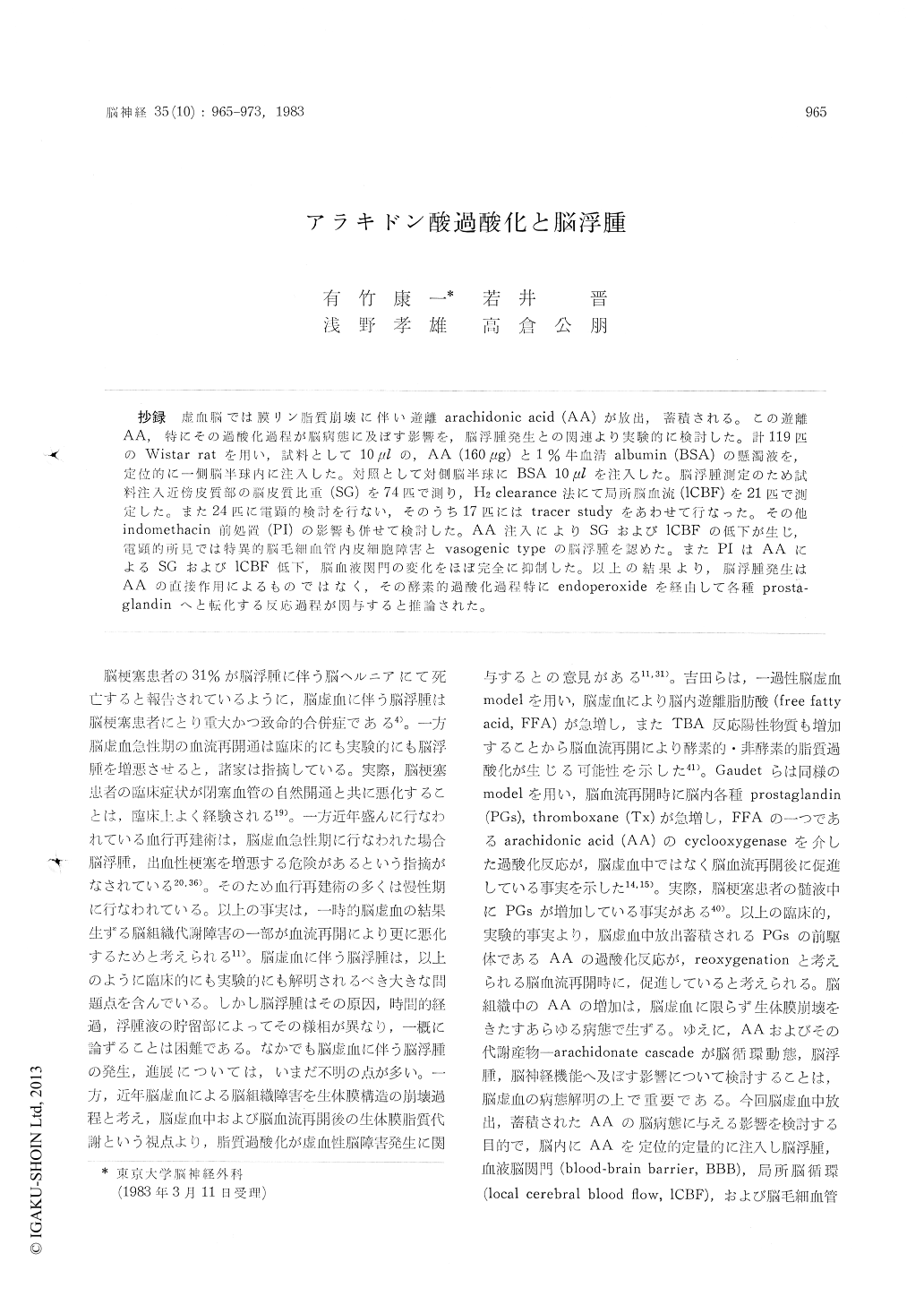Japanese
English
- 有料閲覧
- Abstract 文献概要
- 1ページ目 Look Inside
抄録 虚血脳では膜リン脂質崩壊に伴い遊離 arachidonic acid (AA)が放出,蓄積される。この遊離AA,特にその過酸化過程が脳病態に及ぼす影響を,脳浮腫発生との関連より実験的に検討した,計119匹のWistar ratを用い,試料として10μlの, AA (160μg)と1%牛血清albumin (BSA)の懸濁液を,定位的に一側脳半球内に注入した。対照として対側脳半球にBSA 10μlを注入した。脳浮腫測定のため試料注入近傍皮質部の脳皮質比重(SG)を74匹で測り,H2 clearance法にて局所脳血流(ICBf)を21匹で測定した。また24匹に電顕的検討を行ない,そのうち17匹には tracer studyをあわせて行なった。その他indomethacin前処置(PI)の影響も併せて検討した。AA注入によりSGおよびICBFの低下が生じ,電顕的所見では特異的脳毛細血管内皮細胞障害と vasogenie typeの脳浮腫を認めた。またPIはAAによるSGおよびICBF低下,脳血液関門の変化をほぼ完全に抑制した。以上の結果より,脳浮腫発生はAAの直接作用によるものではなく,その酵素的過酸化過程特にendoperoxideを経由して各種prosta—g1andinへと転化する反応過程が関与すると推論された。
Recent studies suggest that peroxidation ofarachidonic acid (AA) accumulating during ische-mic insult, may be related to the occurrence of post-ischemic brain damage. Since the influence of the increased brain content of AA remains unclear, the present study was undertaken to explore whether the intracerabral injection of AA is associated with the injury of the surrounding brain tissues such as brain edema.
Rats received the intracerebral injection of 10 microliters of test solution (160 microgram of AA emulsified in 1 % bovine serum albumin, BSA) or the same volume of BSA as the control. The measurement of specific gravity (SG) (74 rats) and the local CBF by H2 clearance technique (21 rats), and electron microscopical studies with tracers (Evans blue and horseradish peroxidase, HRP) (24 rats) were carried out. The effect of pretreatment with indomethacin (PI, 10 mg/kg) was evaluated in separate groups.
AA transiently produced a significant decrease in SG and in 1CBF adjacent to the injection sites (p<O. 01). The increased pinocytotic transportation, an accumulation of edema fluid containing HRP in extracellular space and endothelial injuries were observed only after AA injection. The above-mentioned falls in SG and in 1CBF, and the extravasation of HRP were inhibited by PI.
The fact that PI prevented the edema forma-tion, 1CBF change and the disturbance of blood-brain barrier induced by AA, indicates that peoxidation of AA through the arachidonate cascade is involved in the mechanism of brain edema formation. It may be suggested that the increased concentration of AA during an ischemic insult is related to the development of post-ischemic brain edema.

Copyright © 1983, Igaku-Shoin Ltd. All rights reserved.


